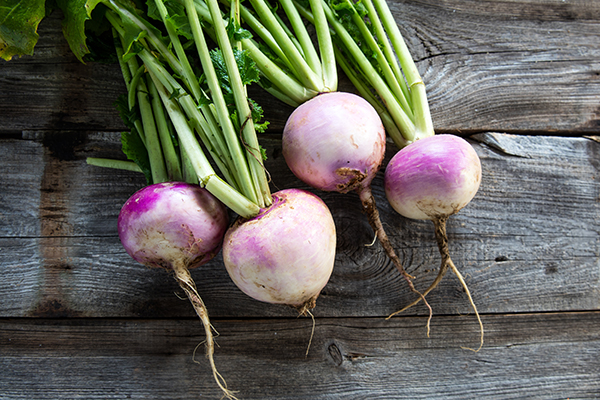We kicked off fall by taking a deep dive into fun facts about pumpkins, and now we’re digging right into turnip nutrition.
Turnips are good for you, and they make a tasty substitute for potatoes. If you haven’t tried turnip fries yet, they’re seriously amazing!
Even cooler?
“You can eat all parts of a turnip, from the crunchy root to the greens made up of the stem and leaves,” says Tamsin Jordan, M.S., R.D., C.D.N., a New York-based registered dietitian specializing in women’s health.
Turnip Nutrition Facts
We’re tempted to call them “faux-tatoes,” but turnips are awesome in their own right. In fact, the nutritional value of turnips is pretty impressive: A cup of cooked turnip cubes has 34 calories and 3 grams of fiber compared to 200 calories and 2 grams of fiber in a cup of potatoes.
If you’re eating the stems and leaves, a cup of chopped turnip greens has only 29 calories but 5 grams of fiber.
“One medium turnip is an excellent source of vitamin C and contains other vitamins and minerals like potassium, phosphorus, calcium, and folate,” says Krista Maguire, R.D.
Now, about those carbs: “Different parts of the turnip contain different amounts of carbs,” says Jordan. “The leafy greens are low in carbs and have a small impact on your blood sugar. The root is more carb-dense; however, compared to similar vegetables, such as potatoes and parsnips, turnips are on the lower end of the carb spectrum,” she explains.
That cup of cooked turnips provides 8 grams of carbs; the potatoes have 33 grams.
Turnip Health Benefits
Eating turnips can help you maintain a balanced diet or crush a cardio class.
“Since it’s a root vegetable in the Brassicaceae family, the same family as other cruciferous veggies, such as broccoli, cabbage, and Brussels sprouts, turnips may provide some of the same health benefits as those do,” says Maguire. “If you combine turnips with plant-based foods high in iron, the vitamin C can help with the absorption of the non-heme iron.”
In addition to that, vitamin C helps build collagen for healthy skin and hair, adds Jordan.
“Turnips are a great addition to a weight loss or healthy eating plan because they’re high in fiber,” says Jordan. “Fiber keeps you feeling fuller for longer, reducing the chance of overeating between meals. It also balances out blood sugar and keeps you regular.”
If you’re working out or playing sports, turnips can provide a boost.
“Turnips have nitrates, which studies show can benefit our cardiovascular system,” says Jordan.
How to Cook Turnips

Turnips are best known for flavoring and thickening soups and stocks, but you can do a lot more than boil them.
The root is a great substitute for potatoes, sweet potatoes, and other starchy vegetables, and the greens work as an alternative to spinach or collard greens.
“Turnips taste like a cross between cabbage and radish,” says Jordan. “They have a slightly sweet, peppery flavor and a crisp, crunchy texture. Choose small- or medium-sized ones because as they get bigger, they get spicier and rougher in texture.”
For meals and snacks, you can use turnips in many different ways:
- Boiled and mashed as a side dish
- Sautéed in a stir-fry
- Cooked in a stew or soup
- Sliced raw for coleslaw or salads
- Shredded raw then quick-pickled as a garnish
- Sliced and baked as turnip fries
“You can also make turnip chips instead of potato chips,” says Maguire. “Or roast them with other root veggies like sweet potato, beets, and parsnips.”








